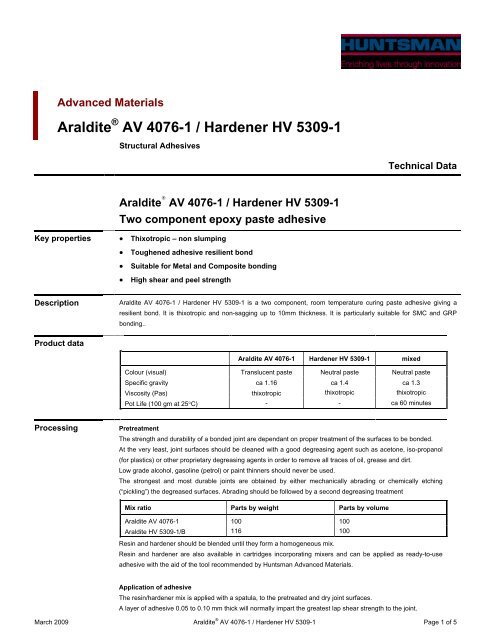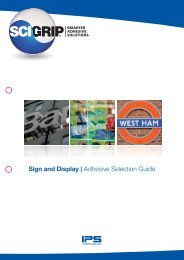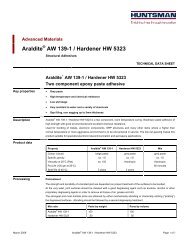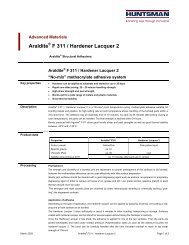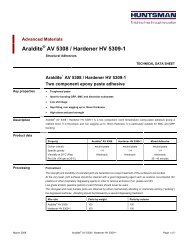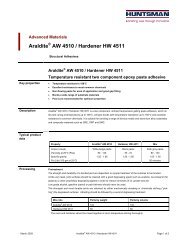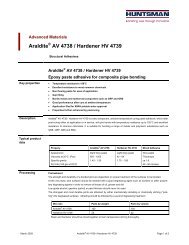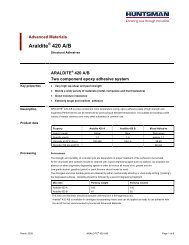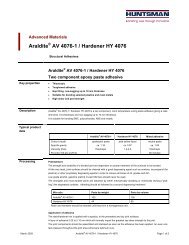Araldite AV 4076-1 / Hardener HV 5309-1 - DanLube
Araldite AV 4076-1 / Hardener HV 5309-1 - DanLube
Araldite AV 4076-1 / Hardener HV 5309-1 - DanLube
You also want an ePaper? Increase the reach of your titles
YUMPU automatically turns print PDFs into web optimized ePapers that Google loves.
Advanced Materials<br />
<strong>Araldite</strong> ® <strong>AV</strong> <strong>4076</strong>-1 / <strong>Hardener</strong> <strong>HV</strong> <strong>5309</strong>-1<br />
Structural Adhesives<br />
Technical Data<br />
<strong>Araldite</strong> ® <strong>AV</strong> <strong>4076</strong>-1 / <strong>Hardener</strong> <strong>HV</strong> <strong>5309</strong>-1<br />
Two component epoxy paste adhesive<br />
Key properties Thixotropic non slumping<br />
Toughened adhesive resilient bond<br />
Suitable for Metal and Composite bonding<br />
High shear and peel strength<br />
Description<br />
<strong>Araldite</strong> <strong>AV</strong> <strong>4076</strong>-1 / <strong>Hardener</strong> <strong>HV</strong> <strong>5309</strong>-1 is a two component, room temperature curing paste adhesive giving a<br />
resilient bond. It is thixotropic and non-sagging up to 10mm thickness. It is particularly suitable for SMC and GRP<br />
bonding..<br />
Product data<br />
<strong>Araldite</strong> <strong>AV</strong> <strong>4076</strong>-1 <strong>Hardener</strong> <strong>HV</strong> <strong>5309</strong>-1 mixed<br />
Colour (visual) Translucent paste Neutral paste Neutral paste<br />
Specific gravity ca 1.16 ca 1.4 ca 1.3<br />
Viscosity (Pas) thixotropic thixotropic thixotropic<br />
Pot Life (100 gm at 25 C) - - ca 60 minutes<br />
Processing<br />
Pretreatment<br />
The strength and durability of a bonded joint are dependant on proper treatment of the surfaces to be bonded.<br />
At the very least, joint surfaces should be cleaned with a good degreasing agent such as acetone, iso-propanol<br />
(for plastics) or other proprietary degreasing agents in order to remove all traces of oil, grease and dirt.<br />
Low grade alcohol, gasoline (petrol) or paint thinners should never be used.<br />
The strongest and most durable joints are obtained by either mechanically abrading or chemically etching<br />
( pickling ) the degreased surfaces. Abrading should be followed by a second degreasing treatment<br />
Mix ratio Parts by weight Parts by volume<br />
<strong>Araldite</strong> <strong>AV</strong> <strong>4076</strong>-1 100 100<br />
<strong>Araldite</strong> <strong>HV</strong> <strong>5309</strong>-1/B 116 100<br />
Resin and hardener should be blended until they form a homogeneous mix.<br />
Resin and hardener are also available in cartridges incorporating mixers and can be applied as ready-to-use<br />
adhesive with the aid of the tool recommended by Huntsman Advanced Materials.<br />
Application of adhesive<br />
The resin/hardener mix is applied with a spatula, to the pretreated and dry joint surfaces.<br />
A layer of adhesive 0.05 to 0.10 mm thick will normally impart the greatest lap shear strength to the joint.<br />
March 2009 <strong>Araldite</strong> ® <strong>AV</strong> <strong>4076</strong>-1 / <strong>Hardener</strong> <strong>HV</strong> <strong>5309</strong>-1 Page 1 of 5
The joint components should be assembled and clamped as soon as the adhesive has been applied. An even<br />
contact pressure throughout the joint area will ensure optimum cure.<br />
Mechanical processing<br />
Specialist firms have developed metering, mixing and spreading equipment that enables the bulk processing of<br />
adhesive.<br />
We will be pleased to advise customers on the choice of equipment for their particular needs.<br />
Equipment maintenance<br />
All tools should be cleaned with hot water and soap before adhesives residues have had time to cure. The<br />
removal of cured residues is a difficult and time-consuming operation.<br />
If solvents such as acetone are used for cleaning, operatives should take the appropriate precautions and, in<br />
addition, avoid skin and eye contact.<br />
Times to minimum shear strength<br />
Temperature C 15 23 40 60 100<br />
Cure time to reach hours 10 6 2 - -<br />
LSS > 1N/mm 2 minutes - - - 40 5<br />
Cure time to reach hours 20 14 4 - -<br />
LSS > 10N/mm 2 minutes - - - 75 12<br />
LSS = Lap shear strength.<br />
Typical cured<br />
properties<br />
Unless otherwise stated, the figures given below were all determined by testing standard specimens made by<br />
lap-jointing 170 x 25 x 1.5 mm strips of aluminium alloy. The joint area was 12.5 x 25 mm in each case.<br />
The figures were determined with typical production batches using standard testing methods. They are provided<br />
solely as technical information and do not constitute a product specification.<br />
Average lap shear strengths of typical metal-to-metal joints (ISO 4587)<br />
Cured for 16 hours at 40°C and tested at 23 C Pretreatment - Sand blasting, degrasing<br />
G<br />
R<br />
A<br />
P<br />
H<br />
Aluminium<br />
Steel 37/11<br />
Stainless steel V4A<br />
Galvanised steel<br />
Copper<br />
Brass<br />
N/mm 2<br />
0 5 10 15 20 25 30<br />
March 2009 <strong>Araldite</strong> ® <strong>AV</strong> <strong>4076</strong>-1 / <strong>Hardener</strong> <strong>HV</strong> <strong>5309</strong>-1 Page 2 of 5
Average lap shear strengths of typical plastic-to-plastic joints (ISO 4587)<br />
Cured for 16 hours at 40 C and tested at 23 C Pretreatment - Lightly abrade and alcohol degrease.<br />
G<br />
R<br />
A<br />
P<br />
H<br />
CFRP<br />
EP-GRP<br />
UP-GRP<br />
SMC<br />
ABS<br />
PA<br />
PC<br />
PMMA<br />
PVC<br />
N/mm 2<br />
0 5 10 15 20 25 30<br />
Lap shear strength versus temperature (ISO 4587) (typical average values)<br />
Cure: 24 hours at 23 C + 30 minutes at 80 C (a) on GRE (b) on aluminium<br />
N/mm 2<br />
30<br />
25<br />
b<br />
20<br />
15<br />
a<br />
10<br />
5<br />
°C<br />
0<br />
-50 -30 -20 0 23 40 60 80 100<br />
Roller peel test (ISO 4578) Cured 16 hours/40 C 4 N/mm<br />
Glass transition temperature (DSC)<br />
Tensile strength at 23 C (ISO 527)<br />
Tensile modulus<br />
Elongation at break<br />
Cure: 16 hours at 40 C<br />
Cure 4 hours at 60°C<br />
ca. 64 C<br />
ca. 78 C<br />
20 MPa<br />
1 Gpa<br />
5 %<br />
March 2009 <strong>Araldite</strong> ® <strong>AV</strong> <strong>4076</strong>-1 / <strong>Hardener</strong> <strong>HV</strong> <strong>5309</strong>-1 Page 3 of 5
Lap shear strength versus immersion in various media (typical average values)<br />
Unless otherwise stated, L.S.S. was determined after immersion for 90 days at 23 C<br />
30 days 60 days 90 days<br />
Cure: 16 hours/40°C<br />
As-made value<br />
IMS<br />
Gasoline (petrol)<br />
Ethyl acetate<br />
Acetic acid, 10%<br />
Xylene<br />
Lubricating oil<br />
Paraffin<br />
Water at 23°C<br />
Water at 60°C<br />
Water at 90°C<br />
MPa<br />
0 5 10 15 20 25 30<br />
Lap shear strength versus heat ageing<br />
Cure: 16 hours/40 C<br />
Test: at 23 C, 50% rh<br />
As-made value<br />
30 days/ 70°C<br />
60 days/ 70°C<br />
90 days/ 70°C<br />
Thermal cycling*<br />
MPa<br />
0 5 10 15 20 25 30<br />
*25 cycles -30 C to + 70 C<br />
Lap shear strength versus tropical weathering (40/92, DIN 50015; typical average values)<br />
Cure:16 hours/40 C: Test at 23 C.<br />
As made value<br />
After 30 days<br />
After 60 days<br />
After 90 days<br />
MPa<br />
0 5 10 15 20 25<br />
March 2009 <strong>Araldite</strong> ® <strong>AV</strong> <strong>4076</strong>-1 / <strong>Hardener</strong> <strong>HV</strong> <strong>5309</strong>-1 Page 4 of 5
Shear modulus (DIN 53445)<br />
Cure: 48 hrs at 23ºC plus 8 hrs at 60ºC<br />
Temperature<br />
G<br />
0 C 0.6 GPa<br />
25 C 0.5 GPa<br />
50 C 0.4 GPa<br />
75 C 0.3 GPa<br />
100 C 100 MPa<br />
125ºC 10 MPa<br />
Storage<br />
Handling<br />
precautions<br />
<strong>Araldite</strong> <strong>AV</strong> <strong>4076</strong>-1 and <strong>Hardener</strong> <strong>HV</strong><strong>5309</strong>-1 may be stored for up to 3 years at room temperature provided the<br />
components are stored in sealed containers. The expiry date is indicated on the label.<br />
Caution<br />
Our products are generally quite harmless to handle provided that certain precautions normally taken when<br />
handling chemicals are observed. The uncured materials must not, for instance, be allowed to come into contact<br />
with foodstuffs or food utensils, and measures should be taken to prevent the uncured materials from coming in<br />
contact with the skin, since people with particularly sensitive skin may be affected. The wearing of impervious<br />
rubber or plastic gloves will normally be necessary; likewise the use of eye protection. The skin should be<br />
thoroughly cleansed at the end of each working period by washing with soap and warm water. The use of solvents<br />
is to be avoided. Disposable paper - not cloth towels - should be used to dry the skin. Adequate ventilation of the<br />
working area is recommended. These precautions are described in greater detail in the Material Safety Data<br />
sheets for the individual products and should be referred to for fuller information.<br />
Huntsman Advanced Materials warrants only that its products meet the specifications agreed with the buyer. Typical properties,<br />
where stated, are to be considered as representative of current production and should not be treated as specifications.<br />
The manufacture of materials is the subject of granted patents and patent applications; freedom to operate patented processes is<br />
not implied by this publication.<br />
Huntsman Advanced Materials<br />
(Switzerland) GmbH<br />
Klybeckstrasse 200<br />
4057 Basel<br />
Switzerland<br />
Tel: +41 (0)61 299 11 11<br />
Fax: +41 (0)61 299 11 12<br />
www.huntsman.com/advanced_materials<br />
Email: advanced_materials@huntsman.com<br />
While all the information and recommendations in this publication are, to the best of our knowledge, information and belief,<br />
accurate at the date of publication, NOTHING HEREIN IS TO BE CONSTRUED AS A WARRANTY, EXPRESS OR<br />
OTHERWISE.<br />
IN ALL CASES, IT IS THE RESPONSIBILITY OF THE USER TO DETERMINE THE APPLICABILITY OF SUCH INFORMATION<br />
AND RECOMMENDATIONS AND THE SUITABILITY OF ANY PRODUCT FOR ITS OWN PARTICULAR PURPOSE.<br />
The behaviour of the products referred to in this publication in manufacturing processes and their suitability in any given end-use<br />
environment are dependent upon various conditions such as chemical compatibility, temperature, and other variables, which are<br />
not known to Huntsman Advanced Materials. It is the responsibility of the user to evaluate the manufacturing circumstances and<br />
the final product under actual end-use requirements and to adequately advise and warn purchasers and users thereof.<br />
Products may be toxic and require special precautions in handling. The user should obtain Safety Data Sheets from Huntsman<br />
Advanced Materials containing detailed information on toxicity, together with proper shipping, handling and storage procedures,<br />
and should comply with all applicable safety and environmental standards.<br />
Hazards, toxicity and behaviour of the products may differ when used with other materials and are dependent on manufacturing<br />
circumstances or other processes. Such hazards, toxicity and behaviour should be determined by the user and made known to<br />
handlers, processors and end users.<br />
Except where explicitly agreed otherwise, the sale of products referred to in this publication is subject to the general terms and<br />
conditions of sale of Huntsman Advanced Materials LLC or of its affiliated companies including without limitation, Huntsman<br />
Advanced Materials (Europe) BVBA, Huntsman Advanced Materials Americas Inc., and Huntsman Advanced Materials (Hong<br />
Kong) Ltd.<br />
Huntsman Advanced Materials is an international business unit of Huntsman Corporation. Huntsman Advanced Materials trades<br />
through Huntsman affiliated companies in different countries including but not limited to Huntsman Advanced Materials LLC in the<br />
USA and Huntsman Advanced Materials (Europe) BVBA in Europe.<br />
<strong>Araldite</strong>is a registered trademark of Huntsman Corporation or an affiliate thereof.<br />
Copyright © 2009 Huntsman Corporation or an affiliate thereof. All rights reserved.<br />
March 2009 <strong>Araldite</strong> ® <strong>AV</strong> <strong>4076</strong>-1 / <strong>Hardener</strong> <strong>HV</strong> <strong>5309</strong>-1 Page 5 of 5


